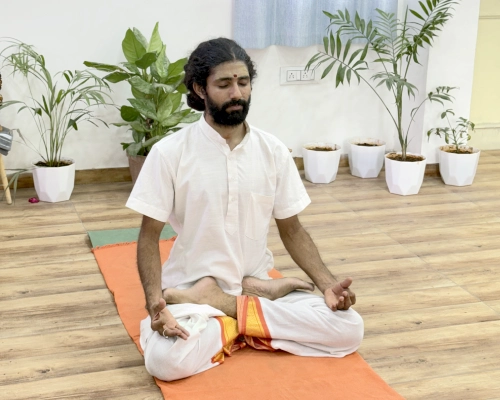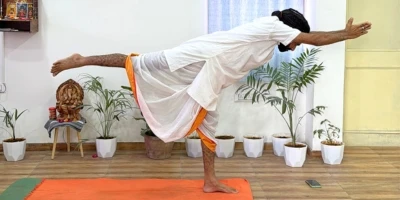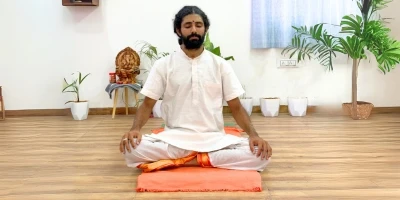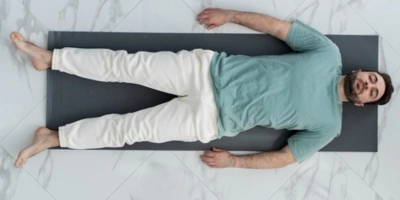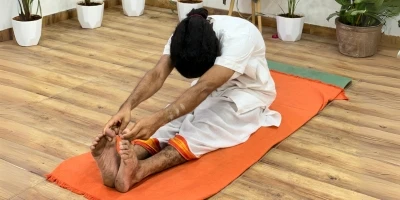Ayurvedic Massage, known as the Abhyanga or Abhyangam, is one of the most important dincharyas (daily regimen) mentioned in the classics for achieving good health and longevity. It includes a full body massage done using herbal oils that have several health benefits. Experts believe that many of the prevalent modern-day massage techniques are the modified forms of Abhyangam.
The health benefits of Abhyangham-massage are mentioned in the Ancient Ayurvedic text Ashtanga Hridaya. It is believed to prevent Ageing, reduce Fatigue, and also diminish the effects of aggravated Vata Dosha.
How is Ayurvedic Massage Performed?
Abhyangam can be performed in several classical positions. At Rudveda, it is done in 7 different classical positions with long flowing strokes. Some Ayurvedic centres perform it in 4 positions. The number of strokes used and amount of pressure applied during massage varies based on the individual’s requirements and ‘Prakriti.’ The herbal oil used for it is customised as per the patient’s Prakriti and presenting conditions. Ayurvedic Massage can be performed as a stand-alone therapy or as a precursor to other therapy regimen; it can be performed by a single therapist or by two therapists working in synchronisation.
What Are the Types of Ayurvedic Massage?
Ayurvedic massages use synchronised motions to stimulate nerve endings to increase blood circulation, thereby channelising early elimination of toxins from the body. The herbs in the medicated oils rejuvenate the tissue and play a vital role in the elimination of toxins and bring a feeling of wellbeing. The lukewarm herbal oil used in Ayurvedic massage stimulates nerve endings thereby improving peripheral blood circulation. The specific long flowing strokes improve the lymphatic flow and promote early elimination of toxins from the body.
- Sarvanga Abhyangam: It is performed on the entire body. Several medicated oils and ghrits are used in this curative and preventive therapy. Sarvanga Abhyangam is done by more than one therapist by applying warm oils all over the patient’s body in seven different positions that are- sitting, lying on back, right lateral, lying on stomach, left lateral, lying on the back, sitting. This Ayurvedic massage involves the application of the right amount of pressure and synchronised circular movements to provide you with a number of health benefits.
Sarvanga Abhyangam relaxes your whole body and alleviates the pain in the muscles. It improves blood circulation and helps you recover faster. Moreover, it strengthens your immune system to keep you shielded from numerous diseases.
- Ekanga Abhyangam is a customised version of the whole body Ayurvedic massage. It is done only on the affected part of the body. The patient is massaged using the warm oils followed by the steam exposure to the affected part.
Ekanga Abhyangam is highly effective in relieving pain and promoting the tissue regeneration. It also tones up the body muscles and helps them in strengthening in order to speed up the recovery of the affected part of the body.
- Padabhyangam is the Ayurvedic foot massage, which aims to improve the functioning of all the organs of the body by stimulating different nerve endings present in the foot. It is performed by using specialised Ayurvedic oils and precise hand movements to revitalise the tired feet.
Padabhyangam effectively reduces swelling in the lower leg and restores health by improving the blood circulation. It also boosts fertility and helps you eliminate health conditions such as Nervousness and Insomnia. This Ayurvedic massage plays an excellent role in preventing Cramps and Dryness as well.
Benefits of Ayurvedic Massage
Ayurvedic massage provides physical, mental, and emotional benefits. It improves overall well-being and promotes longevity. Here are some of the benefits that Abhyangam-Kerala massage provides-
- Improves blood circulation and facilitates the removal of toxins from the tissues.
- Relieves physical and mental Fatigue.
- Reduces muscle Stiffness and Pain. Lubricates the joints and thus reduces Pain and Inflammation of joints.
- Abhyangam also reduces Stiffness, Tightness, Spasm in the muscle and increases the blood circulation to the muscle.
- Increases mental relaxation and promotes better sleep.
- Nourishes the skin and improves its texture.
Which Health Conditions Can Be Managed With Regular Ayurvedic Massage?
It is also known to be beneficial in the management of mental conditions such as Anxiety, Depression, and Insomnia. A daily full body Abhyangam acts as a powerful recharger and rejuvenator of mind and body.
Where Should You Take Ayurvedic Massage And What Is The Cost?
Ayurvedic Massage is one of the most popular Ayurvedic therapies and many Ayurvedic clinics or centers around the city offer it. However, to achieve maximum benefits with the best massage therapy, make sure to visit a professional Ayurvedic center.
Ayurvedic treatments are customised based on every individual’s health needs. Please meet our doctors at the clinic to know the price of therapy.
Padabhyanga refers to Ayurvedic foot massage using herbal oil. It stimulates some special points on the feet that lead to mental relaxation. Padabhyanga is very commonly used as precursor to some of the important Ayurvedic therapies.
Padabhyanga is indicated in following health conditions
- Pain Management
- De-toxification
- Paralysis
- Immunity
- Stress Reduction
- Gastric Problems
- Elderly Care
- Mental Health
What to expect
Herbal foot massage that focuses on vital pressure points to balance the Doshas.
Benefits of Padabhyanga
Prevents spasm, relaxes ligaments and improves circulation to lower limbs. Relaxation of muscles and ligaments leads to Pain Management. Padabhyanga also includes stimulation of some specific points present on our feet that are associated with improvement of vision. The foot massage is also known to improve mood and Mental Health.
How it works
Stimulates internal organs and improves vitality. Stimulation of vital points on feet induces deep metal relaxation and faster body revitalisation.
Not recommended (contraindicated) in case of -
Fever, cold or flu.
Shirodhara massage is a classic Ayurvedic therapy, which includes pouring of warm herbal oil on the forehead in a continuous stream. Ayurvedic Shirodhara therapy is very effective in promoting sound sleep and reducing stress. Shirodhara treatment is one among the Bahiparimarjana chikitsa, or external treatments told in Ayurveda. The term Shirodhara comes from two words “Shira” meaning head and “Dhara” meaning stream.
We briefly explain Shirodhara Massage - Treatment, Benefits & Side effects.
How Does Shirodhara Massage Treatment Work?
Pouring of warm oils used stimulates and soothes the hypothalamus, thereby regulating the functions of the pituitary gland and inducing sleep. Shirodhara stimulates Marma’s or Vital Points in the head and improves circulation. The warm oils used for Shirodhara also cause vasodilatation of all the channels and thereby improve the blood circulation of the brain. Shirodhara also reduces the level of stress hormones such as Adrenaline and Noradrenaline and thus relaxes the mind.
Shirodhara Massage Therapy - Stepwise Procedure
Shirodhara is usually practised in the morning or evening. Depending on the ‘Dravya’ (medicated or non-medicated liquids), it can be called as Tailadhara, Takradhara, Kashayadhara and Jaladhara. Shirodhara is also included as one among the Murdhataila (four special procedures in Ayurveda for the head).
- Shirodhara massage treatment begins with Abhyangam (Ayurvedic body massage).
- You need to lie down on the massage table with closed eyes and relax your body.
- Shirodhara starts with the pouring of about 2 litres lukewarm oil continuously as a stream on to the forehead in an oscillating manner.
- The time duration of Shirodhara treatment may extend from 30 to 60 minutes depending on the condition of the patient. It is important to make sure that the oil does not enter eyes or ears and is therefore recommended to be performed by an experienced therapist
- You may also be given a mild head massage before or during Shirodhara. Shirodhara may also include pouring of buttermilk, decoctions or even water.
How Does Shirodhara Treatment Work?
Pouring of warm oils used stimulates and sooth the hypothalamus, thereby regulating the functions of pituitary gland and inducing sleep. Shirodhara stimulates Marma’s or Vital Points in the head and improves circulation. The warm oils used for Shirodhara also cause vasodilatation of all the channels and thereby improve the blood circulation of brain. Shirodhara also reduces the level of stress hormones such as adrenaline and nor adrenaline and thus relaxes mind.
What are Shirodhara Massage Benefits?
The benefits of Shirodhara massage include treatment of Sleep problems, Memory loss, Poor concentration, Chronic headaches, Stress, Depression, Mental tension, Hypertension, Facial Paralysis and Degenerative conditions of the brain. The medicated oils absorbed through the scalp stimulate the hair follicles, and hence Shirodhara is a vital therapy to treat hair problems such as Premature greying of hair or Hair fall.
Can Shirodhara cause any side effects?
Shirodhara is generally a safe methods. However, precaution needs to be taken to prevent the oil from entering into the eyes or nose. It is therefore advisable to go to a professional Ayuevedic clinic and get shirodhara procedure done from experienced therapists. At Rudveda, all the therapists are well-trained and experienced who perform the Shirodhara Treatment skilfully. If you wish to know the cost of shirodhara at Rudveda, book appointment for consultation and discuss the details with our doctors.
Hairfall problem? Try Shirodhara and see the difference!
Takradhara is a special Ayurvedic treatment that uses medicated buttermilk.Takra means buttermilk and dhara is a stream.The physiological benefits of Takradhara Ayurvedic Treatment are very similar to that of shirodhara. However, the major difference being use of medicated buttermilk.
Takradhara is indicated in following health conditions
- Stress Reduction
- Skin & Hair Care
- Mental Health
- Immunity
What to expect
It includes a continuous flow of medicated buttermilk on the forehead.
Benefits of Takradhara
Buttermilk has cooling properties and induces the same effect on body and mind. Ithelps to relaxthe mind and reduce mental stress.Takradhara prevents greying of the hair, reduces headaches, increases digestive power and alleviates anorexia. It is also useful in insomnia, depression and other stress related ailments.
How it works
Pouring of buttermilk stimulates and soothes the hypothalamus, thereby regulating the functions of pituitary gland and inducing sleep.
Not recommended (contraindicated) in case of -
Chronic sinusitis or cold.
Ksheerdhara treatment refers to flow of herbal milk instead of oil poured over head and body. It is similar to shirodhara, however since it has cooling effects on body it is more suited for the summer months or conditions that needs cooling or relaxing effects.
Ksheerdhara is indicated in following health conditions
- Stress Reduction
- Skin & Hair Care
What to expect
Ksheeradhara involves continuous flow of milk on to the forehead and on the body. It has a cooling effect on your system.
Benefits of Ksheeradhara
Ksheeradhara Ayurveda treatment is useful in treating headaches, insomnia and mental irritability.
How it works
Pouring of medicated milk stimulates and soothes the hypothalamus, thereby regulating the functions of pituitary gland and inducing sleep.
Not recommended (contraindicated) in case of -
Chronic sinusitis or cold.
